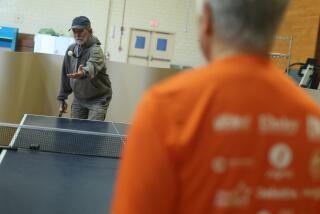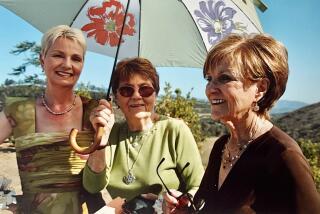Flags Fly Daily for Gold Star Mothers
- Share via
LONG BEACH — At the American Gold Star Manor here, flags wave from balcony after balcony, even when it is not the Fourth of July.
The showing of the Stars and Stripes occurs daily in this cloistered, one-of-a-kind apartment community, where the mothers of servicemen who died while on duty live together.
The flags, say Gold Star mothers, are a symbol of respect for this country and for their lost sons. The display, they say, emphasizes their common bond.
‘Very Patriotic’
“We are very, very patriotic,” said Mae Derry, 68, whose pilot son, John, was killed while on a training mission in 1972. “And even some of the people who live here who are not Gold Star fly their flags in respect for us.”
A minority of the 400 residents in the 23-acre, park-like community at Spring Street and Santa Fe Avenue on the Westside are elderly retirees associated with service-related organizations other than Gold Star.
Together, they live comfortably behind a high security fence, volunteering much time to the Long Beach Veterans Administration Medical Center and other veterans groups and sharing, sometimes for 0many years, a strong common bond.
“There is a camaraderie and a very deep feeling among the Gold Star mothers,” said Derry, who lives with her husband, Walter. “Our monthly meetings are a very solemn and beautiful ritual.”
And on days of national celebration there is a special atmosphere here. Unlike Memorial Day and Veterans Day, when there are elaborate services, the Fourth of July brings a picnic and festivities.
The return of the 39 hostages from Beirut will add to the occasion this year, said several residents. Yellow ribbons still hung from corridor poles this week, even after the hostages were released.
“There is a special kind of pride here,” said Luci Wortman, 55, who is commander of the Long Beach-area auxiliary of the Disabled American Veterans and whose son, David, died in action 13 years ago. Her deceased husband was a disabled veteran.
Wortman, who until recently was the manor’s youngest resident (the oldest is 96), has volunteered more than 5,000 hours at the local veterans hospital, she said.
“Part of the reason I volunteer is because I feel like it is a way of repaying all the good things they did for my husband,” she said.
Wortman did not emphasize her own work with veterans, speaking instead of Gold Star mother Teresa Martinez, who she said was typical of about 30 regularly scheduled volunteers from the manor. Many others contribute time irregularly, and some knit or sew personal items for patients, she said.
“Teresa works in X-ray,” Wortman said. “She stays with the veteran while he’s on the gurney, giving him a kind of one-on-one personal service, so he doesn’t just have to sit there ignored until he’s called. And she does a lot of personal things like calling somebody’s relatives or writing letters. We befriend them.
“The saddest thing we find,” said Wortman, “is that many of them have no money and no home. In this country, where we’re supposed to have everything, it kind of hurts that these people don’t even have a place to take a bath or make a meal.”
Although many of the mothers’ lives revolve around veterans affairs, they emphasize that they are not members of a “crying society.” They say they do not spend time perpetually mourning their lost sons.
“As a matter of fact, there are many of them who don’t even talk about it,” said Wortman. “It’s kind of a silent bond.”
But Muriel Strickland, 88, a resident since 1960, said she and other mothers do talk about their sons. “We talk about them. We remember them.”
And Derry added: “You hear mothers all the time talking about their children, and just because my son is gone doesn’t mean I don’t have remembrances and shouldn’t talk about him.”
Links to Community
The unique Gold Star Mothers home is linked to the larger Long Beach community mainly through veterans work and local churches, which many residents attend, said Strickland.
“The majority come here as strangers to Long Beach,” explained Strickland. “They don’t know the local people or community.”
The home has a tax-exempt, nonprofit status, said its administrator, Edward F. Leonard, a retired Navy captain. The former Navy housing property became a Gold Star Mothers facility in 1955, with the women living in frame bungalows constructed as temporary housing during World War II. In 1975, the federal Department of Housing and Urban Development built 10 three-story apartment buildings for $6.2 million to serve low- and moderate-income Gold Star mothers.
Life in the retirement community, which resembles a small college campus, is safe and pleasant, residents say. Rent averages $200 a month, depending on income, and the amenities include a 1,000-seat auditorium and recreation hall, a therapy pool and Jacuzzi, an arts and crafts center, a library, croquet and shuffleboard courts, a poolroom and acres of lawns and park. Some residents even have their own garden plots.
A concern, however, is that because of too few applications for residency, the home might be lost as a Gold Star facility.
Membership Dwindles
Gold Star Mothers membership nationwide has dropped to about a quarter of its high of 21,000 in the early 1970s, and by 1980 there were too few applications to keep the 348-unit Long Beach home at capacity, Leonard said.
At that time, manor directors voted to allow members of the mothers’ families to reside at the home--five mother-daughter pairs now live there--and to allow other elderly people associated with veterans groups to move in.
“It seems that the Vietnam mothers are not yet ready to join,” said Strickland. “They still have families and jobs.”
Recently, the retirement home has begun trying to contact Long Beach-area mothers of soldiers killed in Vietnam to let them know about the facility, said Leonard.
“There are still people in Southern California and Long Beach who don’t know this facility exists,” he said.
More to Read
Sign up for Essential California
The most important California stories and recommendations in your inbox every morning.
You may occasionally receive promotional content from the Los Angeles Times.













